by Winding Pathways | Aug 6, 2020 | (Sub)Urban Homesteading, Flowers/Grasses, Garden/Yard, Garden/Yard
Learning from the Prairie
Wow. It’s August! We recently completed a management step on the prairie planted in early June. Weeds were outgrowing infant prairie plants that need sunshine. We buzzed off the weeds at the highest setting possible on our battery-powered cordless EGO mower.
We bought this mower because its battery powers a powerful electric mower that easily cuts tough grass while producing less emissions than a gas mower. And, it’s easy to use. No cord pulling to start it. Also, the mow height is simple to set and allows us a high setting that helps with prairie management.
-
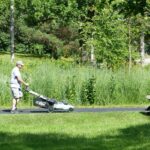
-
The mower and wheelbarrow.
-
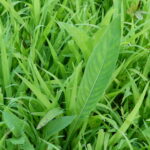
-
Prairie plants among grass.
-
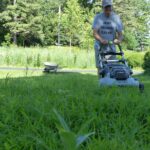
-
Emerging prairie plants will get more sunlight when the competing grasses are mowed off
Afternoon Delight
We planted a prairie in front of the house nine years ago and now spend hours sitting on the front porch reading and talking but always watching the prairie. Here are observations that make us delighted we converted a lawn to the prairie:
- Stunning beauty. We enjoy a changing array of colorful flowers and grasses that dance in the breeze. Coneflowers have been in bloom for a while. Milkweed blooms have faded. And, cupplants are just now coming into their midsummer glory.
- Insects. Monarchs and swallowtails cavort over the prairie on sunny days while stopping to sip nectar. Each evening the air over our prairie swarms with delightful lightning bugs. They are absent over the nearby lawn.
- Wrens, bluebirds, and goldfinches. A pair of wrens nested in a box just above our porch chairs. We love watching these industrious parents make trip after trip foraging for insects to feed the youngsters. They hunt in the prairie and nearby woods edge but not in the lawn. Our prairie enables our yard to support at least four pairs of nesting wrens and one pair of bluebirds. If the entire yard were mowed, we’d be lucky to have one wren couple to enjoy. In mid-summer goldfinches work the prairie.
- Garter and brown snakes. We’ve noticed an increase in garter and brown snakes, both harmless species as beautiful and interesting as goldfinches or cardinals.
-
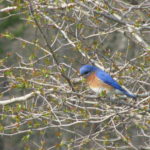
-
Bluebirds hang out on branches.
-
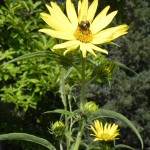
-
This hardy late season bloomer is vital for pollinators and migratory birds.
-
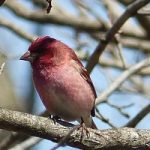
-
Some birds homestead at Winding Pathways.
Phoenix Harmony Labyrinth Prairie
Marion crafted a labyrinth through our oldest prairie on the front yard. She welcomes anyone to walk its circular path. Contact us before you come. The labyrinth is a peaceful way to access the prairie and contemplate the beauty of our earth while walking along its path.
-

-
People call and stop by to walk.
-

-
Visitors can rest and watch the prairie labyrinth.
-
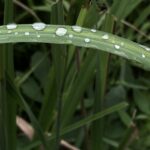
-
Prairie plants capture dew.
-
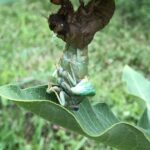
-
A rare treat is watching insect life emerge from one stage to another.
-
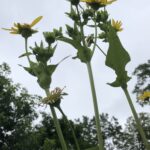
-
Cupplants hold water near their stem. Birds and insects sip
-
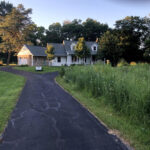
Make Like a Buffalo
When Sustainable Landscape Solutions did ground preparation for our new prairie, I asked Sean Pearl if he’d create two “artificial gopher mounds” in an older prairie in our backyard. He said “Sure.” A while back, we had planted this prairie with just grass seed. It has few flowers, and the roots of the big bluestem, Indiangrass, and switchgrass are tough and dense. Prairie needs disturbance. Once bison wallowed and gophers dug to create bare earth. Many prairie grasses need this bare earth to reseed. We had neither bison nor gophers so used a machine to create bare soil.
Sean’s machine chopped through the grasses. We followed up by planting 82 flower species seeds. Flowers add diversity, color, and attract pollinating insects. Looks like it’s working. Lots of new prairie wildflowers are growing in these two places in the midst of towering grasses.
Our next Prairie Renaissance blog will come in early fall.
by Winding Pathways | May 7, 2020 | (Sub)Urban Homesteading, Garden/Yard, Nature
What’s to Love About a Prairie?
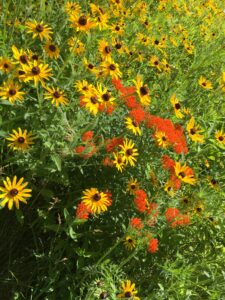
prairie forbs help pollinators
We love prairie. Prairie is color. Flowers yellow, red, blue, and every hue in between shine through tall grasses. Prairie beckons flying flowers……butterflies as well as birds, bunnies, and other interesting animals. Compared to a groomed July lawn, prairies are a joy to our eyes as grasses and flowers wave in the evening breeze.
When we moved to Winding Pathways in 2010, we inherited lawn. Lots of lawn. Starting almost immediately we transformed two big sections into a prairie. But we still had lots of lawn left. So, in late 2019 we decided to whittle it down by about another 3,000 square feet. In-place would be a short profile prairie sporting at least 70 species of wildflowers.
Lawns Have Their Purpose
We’re not anti-lawn. They are great places to relax with friends and play. There’s just too much lawn in America and its environmental impact is huge. Lawn watering annually consumes 3 trillion gallons of irrigation water, 200 million gallons of gas for mowing, and 70 million pounds of pesticides. There’s no need for that.
Ways to Ecologically Manage Lawns
- Allow diverse plants to grow.
- Avoid watering or spraying.
- Mow on a high setting. We use a battery-powered EGO mower that’s recharged by our solar electric panels.
There are lots of ways to establish a prairie. None is perfect. Some yield fairly quick results, while other methods require patience. Through a series of blogs this year we will detail how we decided to plant prairie, explain its benefits, and detail a way to achieve fairly fast results. Ours is just a model of one way to do it. We encourage anyone who has a lawn to consider transforming it into prairie or other native vegetation even if it’s only a few square feet.
Why We Are Doing It: Decision…
There are lots of reasons for converting a lawn to a prairie. Here are a few of ours:
- We’re individualists. We find neighborhoods with rows of perfectly clipped, fertilized, and sprayed lawns boring.
- We thrive on diversity. Every new bird, plant, and animal discovered in our yard is a thrill. Ecologists who have long said that diversity implies stability, are correct. Species change from year to year but always there’s change within the stability of a healthy habitat – our prairie.
- We consider mowing a waste of time and resources. Nationally, lawn mowing consumes millions of gallons of gas. Mowers spew out emissions that foul the air and contribute to climate change. Mowing is time-consuming.
- With a few exceptions, we shun chemicals. We’ve never used any insecticides and only use a few herbicides to help our prairie compete with persistent introduced plants.
- It’s all about beauty. As we sit on our summer porch colors dance in the wind from hundreds of blooming plants and butterflies hopscotch about. Prairie is a joy to the eye.
- Water is precious. Perhaps the world’s most precious resource is clean water. Deep-rooted prairie, unlike lawns, never needs irrigation. Instead, it filters, cleanses, and sequesters rain that percolates down to the water table through zillions of interlocking roots.
- Years ago, we restored one prairie. But on the other side of the drive is a swath of lawn that continually needed mowing. Worse yet, it was on a slope, causing our creaking knees to work extra hard pushing the mower upslope. So, in late 2019 we decided to convert part of it to a prairie, leaving a margin of a mowed lawn around it.
…and Early Preparation
So, we began to plan our newest prairie. Unlike the existing ones we wanted it to establish as quickly as possible and we wanted great plant diversity and lots of color with only one exception. We wanted a short-grass/forb prairie, so chose the seeds carefully. We chose not to include Big Bluestem, Switch, and Indian Grasses in our mix.
We also had to determine these things:
- Was it legal in our area? Yup. We checked ordinances.
- Would it bother the neighbors? No. We informed them and learned they were fine with it.
- Did we have the time and money to establish and maintain it? Yup. We are frugal and energetic enough to maintain and nourish the prairie.
Just What Is Prairie?
Native prairie is an enormously complex and beautiful grassland that became established in the American middle after the glaciers receded and the climate warmed and dried. It stretched from Ohio to the Rocky Mountains. Eastern prairies lived where rainfall and humidity were fairly high. It was nearly plowed to extinction and was replaced by vast corn and soybean fields. Shortgrass prairie can be just ankle high and lives in the dry Great Plains with the mid-grass prairie in between. We live in the area once occupied by tallgrass prairie, a truly endangered ecosystem. Establishing prairie is appropriate in areas that were once prairie and it is ecologically wonderful to replace lawns with vegetation native to the site.
Winding Pathways is partnering the project with the Monarch Research Project, Linn County Roadsides, Sustainable Landscape Solutions, and Pheasants Forever.
Now on to the next phases of our Prairie Renaissance. (For earlier background on pollinator patches read our blog of February 20, 2020.)
-
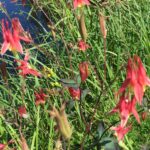
-
Columbine blooms early in the season
-

-
Bluebirds hang out on branches.
-
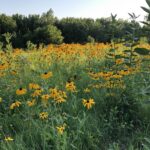
-
Blackeyed Susans populate a prairie.
-
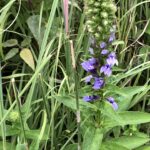
-
Blue lobelia is one of the more demure forbs that attract pollinators.
-
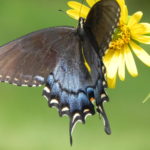
-
Black Swallowtail butterfly on cup plant.
-
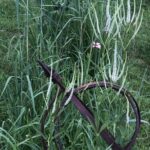
-
Culver’s Root sends up white candles of blooms.
-
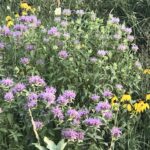
-
High summer flowers like monarda and yellow coneflower attract butterflies
-
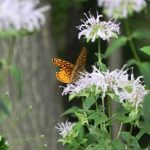
-
Summer is the time to attract and enjoy butterflies.
-
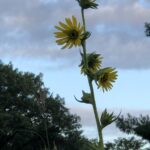
-
Compass plant is among the late summer forbs.





















